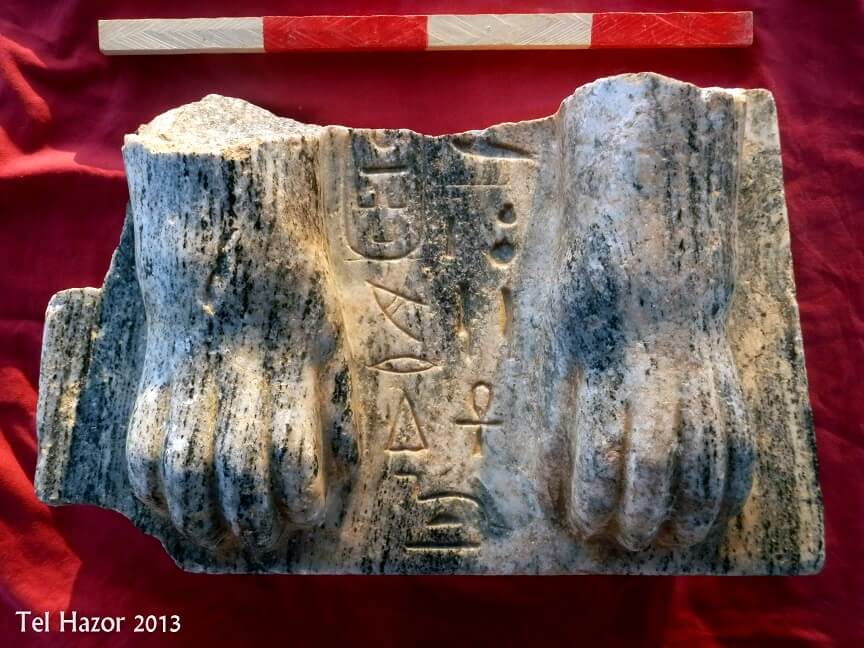Historical discovery: Archaeologists from the Hebrew University discovered in excavations at Tel Hazor a one-of-a-kind sphinx fragment of an Egyptian king from the builders of the Giza pyramids

At a time when Egypt is going through a second revolution in two and a half years and its various parties are fighting for control of the country, archaeologists from the Hebrew University discovered a magnificent and ancient evidence of Egyptian rule precisely in Tel Hazor near Rosh Pina. A team of researchers led by Prof. Amnon Ben-Tor and Dr. Sharon Zuckerman from the Institute of Archeology found a unique Egyptian Spinach fragment in the Tel Hazor National Park. The sphinx carries between its front legs an inscription in the Khartoum script that includes the name of the Egyptian king Mikrinus, from the days of the ancient Egyptian kingdom, one of the builders of the well-known pyramids of Giza, who ruled the kingdom in the third millennium BC.
The fragment of the sphinx discovered in Hazor is an unexpected and amazing discovery in its importance, since the sphinx of this king is the only one so far known in the entire world, including Egypt itself. Moreover, it is the only fragment of a monumental royal statue discovered in the entire Levant. Besides the king's name, the inscription includes the titles "beloved of the divine incarnations...who gave him eternal life". According to Prof. Ben-Tor and Dr. Zuckerman, the inscription shows that the original location of the Spinach was probably in the city of Heliopolis, the biblical On, which is north of present-day Cairo.
The archaeological complex in which the Spinach is found is within the layer of ruins of the city that was destroyed during the 13th century BC, at the entrance to the city palace. The question that is now interesting to the researchers is when and under what circumstances the statue was brought to Hazur. According to Prof. Ben-Tor and Dr. Zuckerman, the probability that the sphinx was brought to Hezor already in the days of the king whose name is engraved on it is extremely small, since there is no information about the existence of any connections between Egypt and the Land of Israel in the third millennium BC. Two more likely possibilities: It is possible that the statue was brought to the Land of Israel in the second millennium BC during the dynasty of kings known as the Hyksos, which originated in Canaan. It is also possible that the Spinach was brought to Israel during the 15-13th centuries BC, when Canaan was under Egyptian rule, as a gift from the King of Egypt to King Hazor, the ruler of the most important city in the southern Levant at that time.
Tel Hazor is the largest and most important of the biblical mounds of the country and was designated as a world heritage site by UNESCO. The Israeli Hazor is a key site for testing the reliability of the biblical histography, and it was preceded by the Canaanite Hazor, who was called the "head of all these kingdoms" in the book of Joshua. The city had cultural and commercial ties with both Egypt and Babylon, and written documents discovered both in Hazor and in these two important centers clearly testify to this. Along with the written documentation, various artistic findings were also revealed, including those that were brought to Khor from near and far.
The Hebrew University excavated the site for the first time in the mid-1990s and also excavated it in the late 2006s. The excavations at the site were renewed in XNUMX, as part of the Saltz Foundation excavation project in memory of Yigal Yedin, by Prof. Amnon Ben-Tor, who was joined by Dr. Sharon Zuckerman in XNUMX. The current excavation in the area is managed by Shlomit Bacher, a doctoral student of the Institute of Archeology and is being conducted under the auspices of the Society for the Investigation The Land of Israel and its excavations in collaboration with the Antiquities Authority and the Nature and Parks Authority.

3 תגובות
The article assumes that the statue was brought from Egypt.
Maybe the statue was sculpted in Tel Hazor? Pharaoh fans!
maybe yes …
The hypothesis that the statue was exported to Israel as a gift seems to me to be mere speculation without evidence. It is hard to guess why a statue would be exported to Israel.
My speculation (also without evidence) is that the Hyksos who were expelled from Egypt, in the northern part of which they ruled until the expulsion as pharaohs, were the ones who dragged the statue to Israel (because they did not give up their hope to return and conquer northern Egypt). In the end, the statue they dragged with them got stuck in Hazor, which was a sort of capital city of northern Canaan at that time. As mentioned, this is only speculation because without evidence no one knows why the statue got stuck in Hazor.
What is the size of the statue?
And regarding the possibility that this sphinx was handed over as a gift from an Egyptian king to the king of Hazor:
Isn't that a form of blasphemy?
The ancient Egyptian rulers are known to consider themselves and their predecessors as gods, so giving a statue that symbolizes the ancient god... is like a Jewish king giving the Ark of the Covenant or the temple lamp as a gift to some king inferior to him (as Hazor is inferior to the Egyptians) isn't it?
Either I'm really, really ignorant of the Egyptian mentality of the ancient period or the idea of "gifting" is completely absurd..